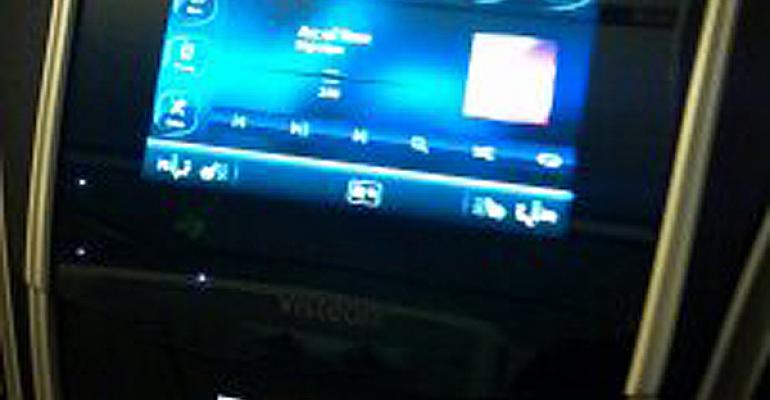VAN BUREN TOWNSHIP, MI – In-vehicle infotainment touchscreens are nothing new, but Visteon says its OEM customers are looking for something more.
“A lot of our customers are looking for a high-quality, high-craftsmanship look (to touchscreens) and don’t want to see the display poke through,” James Kornacki, global platform and subsystem development manager-center-stack electronics, tells WardsAuto in a recent interview here.
To satisfy customer demand, the supplier has developed a screen that is completely black when not in use, accenting the visual appeal of the center stack, he says. Visteon has several terms to describe the technology, including “black effect,” “dead front” and “secret to lit.”
The screen also has a slight curve to it, a design cue not commonly found in current production touchscreens.
Curving the screen required the transition from a resistive screen to a capacitive screen. While similar in operation, capacitive touchscreens are able to detect multiple inputs, while resistive types can detect only one input at a time.
Resistive screens are more commonplace because they are more affordable, but Kornacki says capacitive technology is quickly becoming more desirable.
“That trend has really swept through the consumer-electronics industry,” he says.
Visteon first developed prototypes of the technology in 2009, and the current version could hit the market by 2014, Kornacki says, noting there is significant customer interest in it.
In addition to designing the curve, there were other hurdles to overcome in developing the system, which only allows about 35% of the light from the display unit beneath the overlay to shine through when activated.
To get any light to shine through the dark surface, the display unit has to be exceptionally bright, which can add costs. The bend also can cause birefringence, which can create an undesirable rainbow effect if viewed from certain angles.
“This is a birefringence-free touch lens, so the touchscreen inside also has to be birefringence free,” Kornacki says.
Currently the screen can be curved only in one spot because of its multi-layered nature. Kornacki likens it to a piece of paper, noting “you can bend it in one direction, but can’t simultaneously bend it in two.”
Other technologies that could accommodate multiple curvatures are being developed. Kornacki says that while they show promise, they’re still in the evaluation phase.
Another demand from auto makers is faster response time from touchscreens. Consumer feedback indicates frustration among users when a quick touch takes more than a split-second to initiate the desired function.
“We tried to design the interface to be as fast as possible,” he says. “We also have tactile and audio feedback on this, so we’re going for the full experience.”
Visteon’s display has conventional knobs for audio volume and fan control, as well as a dedicated area on the touchscreen for heating, ventilation and air-conditioning settings. Those were put in place to alleviate customer complaints over having to navigate through multiple screens to activate commonly used controls, he says.
Another feature of the system, which Kornacki admits some have called “gimmicky,” is spatial-gesture control. The feature allows a user to swipe his hand over the screen in a certain direction to perform simple functions, such as switch a track on a compact disc.
OEM customers are interested in the technology but are demanding it be pushed further, he says.
“Some of our customers are saying, ‘When I come in and interact with the touchscreen, I want to know whose hand it is,’ because they maybe want to do something different with their human-machine interface for driver vs. passenger,” Kornacki says.
“A driver’s hand could be for simple commands, while a passenger’s hand could be for something more complex,” he adds. “We’re working on this, and it’s (close) to going into prime time.”





